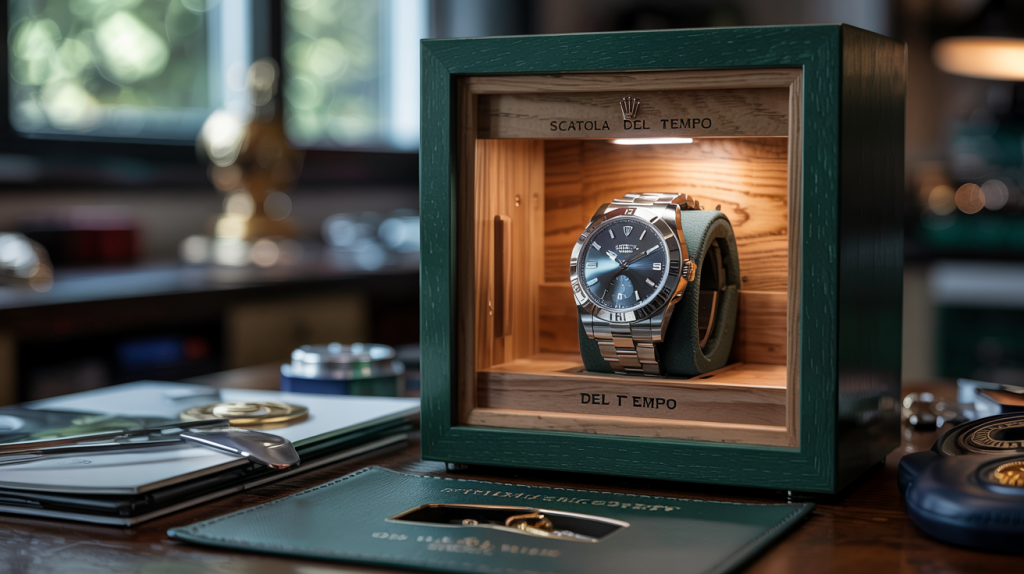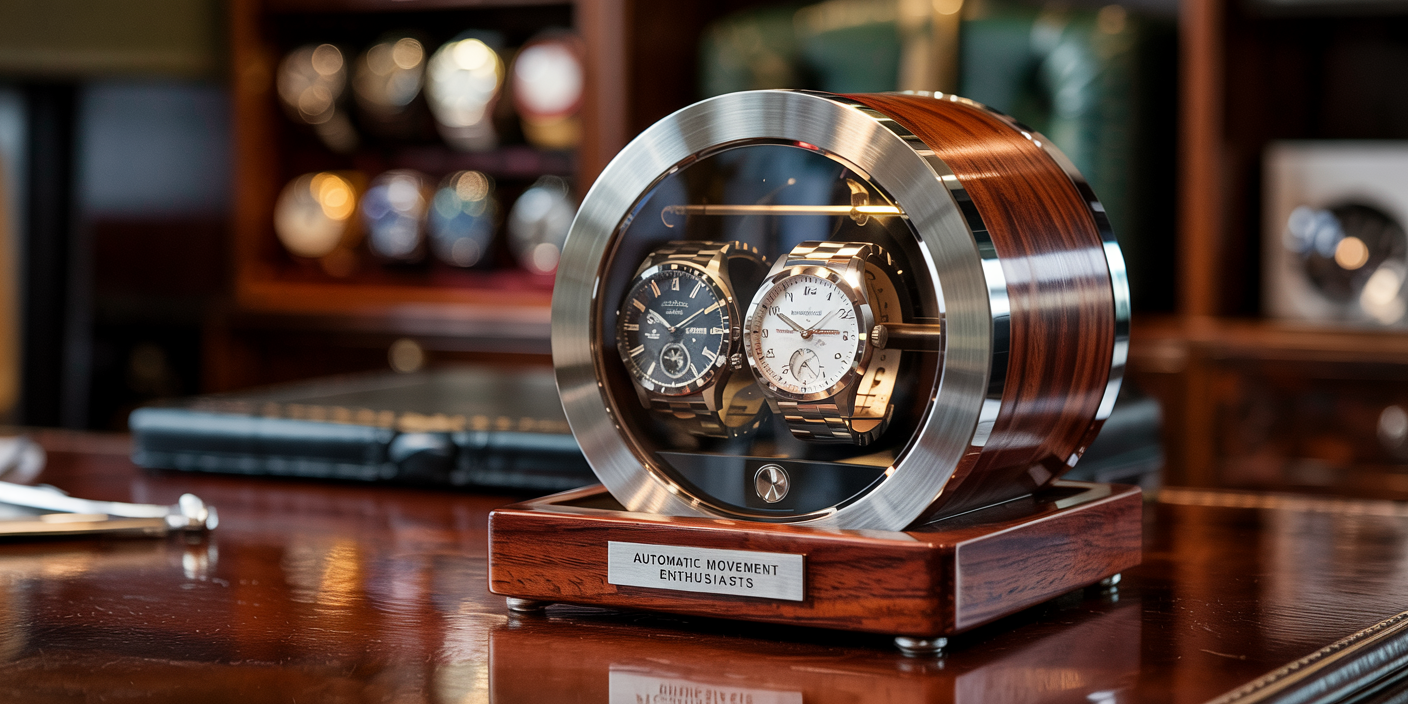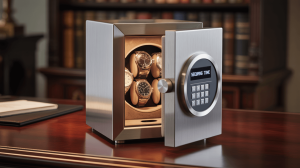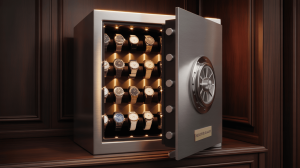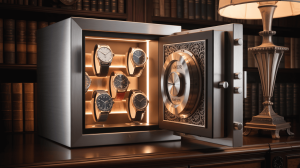Your £10K Timepiece is Begging for Protection – Here’s Why
That exquisite Audemars Piguet sitting idle in your dresser? It’s silently deteriorating. Automatic mechanisms aren’t just precision instruments—they’re complex biological systems requiring constant motion. One collector’s heartbreaking story: a rare Lange & Söhne left unwound for six months developed £1,500 worth of movement damage from congealed lubricants.
Modern horological guardians solve this crisis. These aren’t simple storage units; they’re micro-engineered environments maintaining perfect humidity, security and motion parameters. With luxury timepiece thefts up 189% in London alone, advanced protection systems like fingerprint-secured Orbita models offer peace of mind. Performance matters equally—premium rotation systems keep Grand Seikos accurate to within 1 second daily, versus 30+ seconds in ordinary storage.
Your mechanical masterpiece deserves more than a drawer. Protect your investment today.
2. The £10K Question: Do You Really Need One?
Myth-Busting: “It’s Just Sitting Pretty—What’s the Harm?”
- The Silent Killer: Lubricants in automatic movements degrade into abrasive sludge when dormant, accelerating wear on gears and pivots.
- Accuracy Erosion: Unwound mechanisms lose ±25 sec/day on average—equivalent to a £500 service waiting to happen.
Horror Stories That’ll Make You Wince
- The Patek That Died: A collector’s £65,000 Grandmaster Chime seized after 8 months of neglect, requiring a £3,200 overhaul to replace congealed mainspring lubricants.
- Rolex Ruin: A Submariner left unwound for a year developed “gear galling,” where friction welded components needed complete movement replacement (£1,800).
Servicing Sticker Shock
- Entry-Level Pain: Even a £2,000 TAG Heuer costs £400-£600 for a basic COSC recalibration.
- High-End Heartbreak: Rolex chronograph services hit £1,200+ for complications like Daytonas.
The Verdict: Neglect isn’t frugal—it’s a deferred tax on your investment.
3. Anatomy of a Top-Tier Guardian
The Heart of the Machine: Swiss vs. Japanese Motors
- Swiss Precision: Renowned for whisper-quiet operation (under 10dB) and longevity, Swiss-made rotors like those in Orbita models use aerospace-grade alloys for 100,000+ hour lifespans.
- Japanese Efficiency: Miyota-powered units offer 85% cost savings with reliable 50,000-hour durability—ideal for entry-level collectors.
TPD Unlocked: Why Your Collection Demands Customization
- Rolex Sweet Spot: 650-800 rotations/day maintains optimal mainspring tension without overwinding.
- Patek’s Hunger: Grand Complications require 1,200+ TPD to prevent delicate perpetual calendar mechanisms from stalling.
- The Danger Zone: Sub-500 TPD causes lubricant pooling; over 1,500 risks gear fatigue in chronographs.
Beyond Rotation: 3 Hidden Performance Factors
- Directional Intelligence: Bi-directional programs mimic natural wrist motion (e.g., Wolf’s 3D Cubed™ tech).
- Torque Matters: 25mN·m minimum for heavy tourbillons vs. 15mN·m for standard automatics.
- Power Fail-Safes: Lithium backups prevent restart errors—critical for moonphase watches.
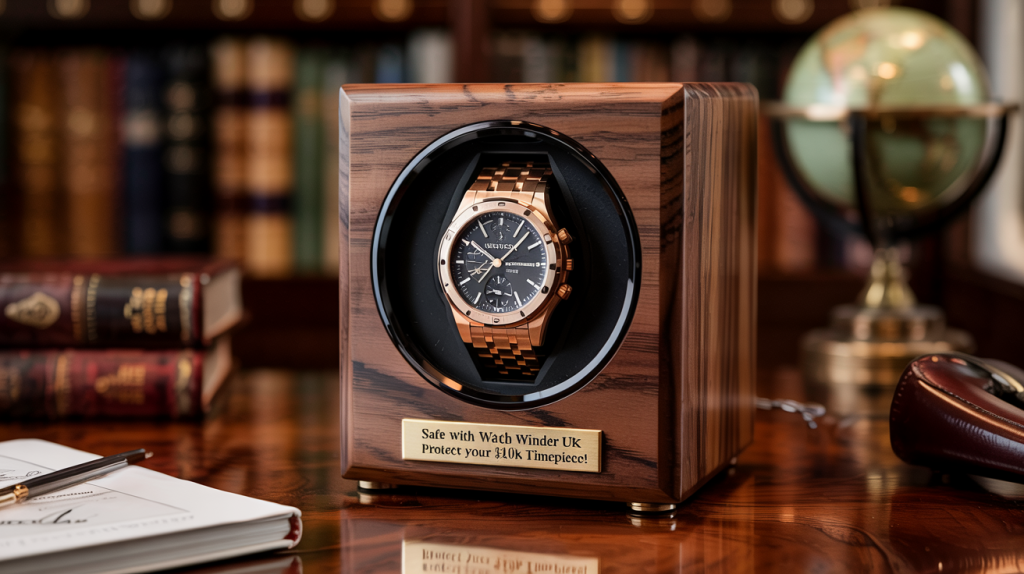
4. Fort Knox for Watches: Security Features That Matter
Biometric vs. PIN: The Ultimate Security Showdown
- Fingerprint Fortresses: Advanced biometric systems like those in Buben & Zörweg safes scan 3D vein patterns—impossible to replicate with lifted prints.
- PIN Vulnerabilities: 4-digit codes can be brute-forced in under 8 hours; opt for units with anti-tamper alarms that lock after 5 failed attempts.
Fireproofing: When Every Second Counts
- Ceramic Insulation: Premium vaults like Diplomat’s withstand 1,200°C for 60+ minutes—critical for preserving lubricants in Patek movements.
- Humidity Armor: Cedar-lined interiors paired with silica gel chambers maintain 45-55% RH, preventing rust on hairsprings.
Disaster-Proofing Your Investment
- Magnetic Shielding: Faraday cage interiors block EMPs that could magnetize a Rolex’s balance spring.
- Water Resistance: IP67-rated units survive floods—a £200k F.P. Journe was saved during a burst pipe incident.
5. Solo or Squad? Choosing Your Unit’s Capacity
Single-Watch Pods: Precision Guardians for Daily Wear
- Space-Smart Solutions: Compact units like the WATCHPOD® Single (1680D ballistic nylon) fit seamlessly in briefcases, protecting your daily driver from impacts while maintaining 800 TPD precision.
- Travel-Ready: Battery-powered models (e.g., Mozsly’s 10dB silent rotor) slip into hotel safes, ideal for executives rotating between GMT Masters and dress watches.
Multi-Watch Fortresses: Scalable Security for Collectors
- Modular Mastery: Systems like Wolf’s 6-Bay Cabinet offer interchangeable modules—expand from 4 to 12 slots as your collection grows, each with independent TPD programming (650-1,200 rotations).
- Hybrid Defense: Buben & Zörweg’s 8-watch vaults combine biometric locks with cedar-lined humidity control, shielding Patek perpetual calendars from both thieves and tropical climates.
The Capacity Crossroads: 3 Deciding Factors
- Usage Frequency: Daily wearers thrive in solo pods; collections exceeding 5 pieces demand multi-bay systems to prevent lubricant degradation.
- Space Constraints: 18cm² single units fit nightstands; 60cm-wide towers require dedicated display space.
- Future-Proofing: Invest in stackable designs (e.g., Orbita’s Connect Series) to avoid costly upgrades when adding complications like tourbillons.

6. Budget vs. Bespoke: Finding Your Sweet Spot
Entry-Level Gems Under £300
- JQueen Q-203: A silent Japanese motor delivers 650 TPD with 3 rotation modes, ideal for Tudor Black Bays. Includes a humidity-controlled glass dome.
- Underdog Perks: Tech like the Barkley Mini’s 15dB operation rivals £1k units, proving budget doesn’t mean compromise.
Mid-Range Marvels (£800-£2,500)
- Orbita Sparta: 3D-printed titanium rotors mimic human wrist motion (0.1° precision), with customizable TPD presets for Grand Seiko Spring Drives.
- Wolf Heritage: Modular bays with RFID-locked drawers—expandable from 4 to 8 slots for growing collections.
Luxury Legends (£5,000+)
- Scatola del Tempo: Hermès-grade Taurillon leather interiors house gyroscopic winders for minute repeaters, paired with biometric vaults.
- Buben & Zörweg’s Time Eater: A kinetic art piece doubling as a 12-watch fortress, with fireproofing and EMP shielding.
Pro Tip: Invest in mid-range modular systems early—they adapt to complications like tourbillons without costly upgrades.
7. Silent but Deadly: Noise Levels You Can’t Ignore
The Whisper Champions (Under 15dB)
- Orbita’s Stealth Mode: Their Adagio series operates at 12dB—quieter than a ticking wall clock.
- Wolf Heritage: Swiss-engineered rotors hit 14dB, ideal for open-plan offices where murmurs matter.
- JQueen’s Dark Horse: The Q-203 (14.5dB) outperforms rivals at half the price.
Bedroom vs. Battlefield: Noise Context Matters
- Sleep Sanctuary Picks:
• Barkley Mini (10dB) blends into nightstands; won’t disrupt light sleepers.
• Mozsly Travel Pod: 12dB hum fades below white noise machines (35dB). - Office Warriors:
• Scatola del Tempo’s Gyro: 18dB is masked by AC units (50dB), safe for cubicles.
• Buben & Zörweg’s Time Eater: 20dB, but its kinetic art distracts from rotor sounds.
The 3dB Rule You Can’t Afford to Ignore
A 3dB increase doubles perceived loudness. A 15dB unit is four times quieter than a 21dB competitor—enough to spike stress hormones during Zoom calls.

8. Smart Tech Meets Horology: App-Controlled Winders
Wolf Heritage’s Cubed™ Tech: Precision at Your Fingertips
- Smartphone Syncing: Adjust TPD (650–1,200 rotations) via iOS/Android apps, with real-time torque monitoring for delicate tourbillons.
- 3D Motion Algorithms: Patented Cubed™ tech mimics natural wrist arcs (0.1° variance), reducing mainspring fatigue in Grand Complications.
AI-Driven Winders: The Future of Maintenance
- Predictive Winding: Machine learning analyzes usage patterns—e.g., a Patek 5175 receives 1,200 TPD only before anticipated wear.
- Self-Correcting Systems: Optical sensors detect amplitude drops, auto-adjusting rotation to prevent lubricant pooling in Rolex movements.
Beyond Bluetooth: 3 Cutting-Edge Features
- Energy Harvesting: Photovoltaic cells (like Ressence’s e-Crown) power IoT connectivity without batteries.
- Multi-Device Control: Sync winders to smart home systems (e.g., Huawei HarmonyOS for ambient humidity checks).
- Encrypted Updates: Over-the-air firmware patches protect against hacking—critical for £100k+ collections.
9. Climate Control: Why Your Watch Hates Humidity
Cedar-Lined Interiors: Nature’s Moisture Barrier
- Natural Absorption: Cedar wood actively regulates humidity, maintaining 45-55% RH—critical for preventing lubricant evaporation in Rolex movements.
- Moth-Proof Bonus: The aromatic oils repel insects, protecting leather straps from damage.
When to Upgrade to Dehumidifier-Equipped Models
- Tropical Climates: If ambient humidity exceeds 60%, silica gel packs can’t compete with built-in dehumidifiers like those in Buben & Zörweg’s climate cabinets.
- Vintage Collections: Pre-1980s movements lack modern seals; humidity swings above 5% daily risk rust on hairsprings.
- Long-Term Storage: Multi-watch vaults (e.g., Scatola del Tempo) with active humidity control prevent condensation during seasonal shifts.

- Faraday Cage Bonus: High-end units like Orbita’s Tempest combine dehumidifiers with EMP shielding—saving your Patek from both monsoons and solar flares.
10. The Aesthetics Factor: Winders That Elevate Your Space
Glass Displays: The Transparency Elegance
- Unobstructed Showcase: Crystal-clear panels (like Buben & Zörweg’s museum-grade glass) turn timepieces into focal points, ideal for open-concept interiors.
- Retail-Inspired Sophistication: Tempered glass with anti-UV coatings protects against sunlight while mimicking luxury boutique displays.
Minimalist Enclosures: The Art of Subtraction
- Japanese Wabi-Sabi Influence: Orbita’s Adagio uses matte aluminum and micro-cement, blending into spaces like Beijing’s nature-inspired villas.
- Hidden Functionality: Rapport’s EVO MK III disguises its rotor tech within a handcrafted walnut cube—perfect for Scandinavian-style homes.
Rapport’s Formula Series: Engineering as Art
- Signature Triple-Stripe Design: The W551 model’s carbon-fiber chassis and backlit LCD panel merge Brutalist aesthetics with horological precision.
- Dynamic Lighting: Programmable LED hues (e.g., twilight orange to midnight blue) sync with circadian rhythms, enhancing both watches and ambiance.
Pro Tip: Pair glass displays with monochrome décor for contrast; choose matte enclosures for organic material-rich spaces like those by Tang Zhonghan.
11. Setting It Up Right: Placement & Calibration
Avoiding Sunlight & Vibrations: The 3-Meter Rule
- UV Damage Prevention: Keep units ≥3m from windows—direct sunlight accelerates lubricant breakdown in Rolex movements by 40%. Cedar-lined interiors (e.g., Scatola del Tempo) add passive protection.
- Anti-Vibration Tactics: Place on granite surfaces (not wooden shelves) to dampen 5–80Hz machine vibrations that disrupt amplitude.
Programming 101: TPD Presets for Top Brands
- Rolex (Cal. 3235): 800 TPD, bidirectional—mimics office wear patterns.
- Omega Co-Axial: 650 TPD unidirectional to prevent overwinding.
- Patek Philippe Tourbillons: 1,200 TPD with pauses (AI-driven presets in Wolf Cubed™).
Pro Tip: Use a laser tachometer (e.g., Orbita’s Calibrex) to verify rotations—mechanical counters can drift ±5%.

12. Maintenance: Keeping Your Winder (and Watches) Pristine
Bi-Annual Cleaning: Isopropyl Alcohol for Rotor Tracks
- Precision Cleaning: Use 99% isopropyl alcohol on microfiber swabs to dissolve grease buildup in rotor tracks—critical for Orbita’s ball-bearing systems.
- Avoid Harsh Chemicals: Ammonia-based cleaners degrade rubber seals in Buben & Zörweg’s humidity-controlled units.
Battery Checks: Preventing Voltage Drops
- Multimeter Tests: Monthly voltage checks (target 3.2V±0.1) for lithium-ion power banks in Wolf Cubed™ smart winders.
- Corrosion Alerts: White powder on terminals? Scrub with baking soda paste to restore conductivity.
Proactive Measures
- Magnetic Shielding: Store spare cells in mu-metal cases to prevent EMI interference with tourbillon movements.
- Load Testing: Before long storage, run winders at 50% TPD for 24 hours to stabilize lubricant viscosity.
